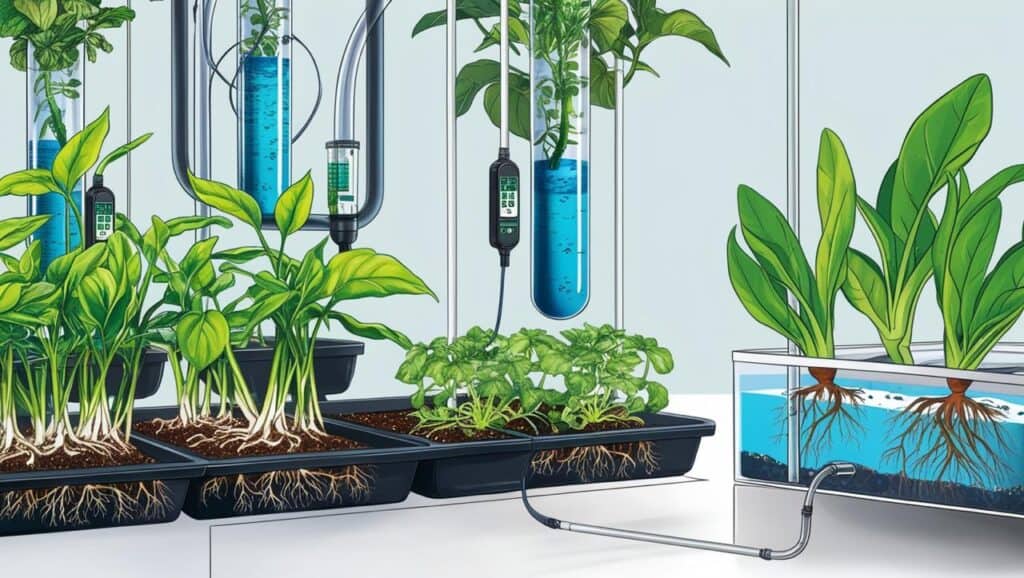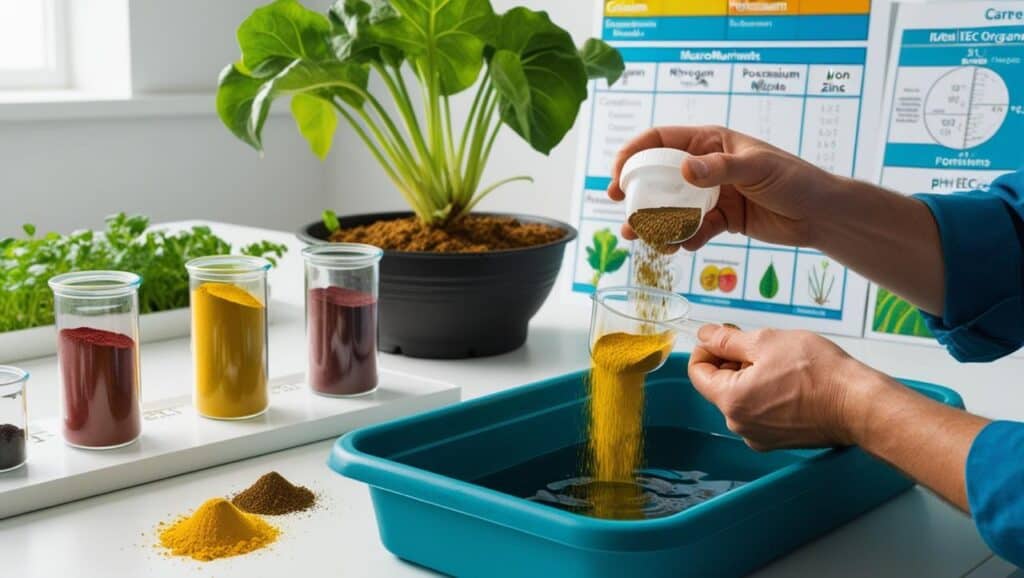
Growing plants without soil requires getting the liquid nutrients just right. This guide will show you how to mix up a “recipe” for a hydroponic solution that keeps pH and EC in balance. You’ll learn which salts to use and how much of each one. With the proper nutrient levels, your plants won’t miss the dirt!
Key Takeaway
- A balanced nutrient solution is crucial for optimal plant health and growth.
- Regularly checking pH and EC levels helps ensure nutrients are accessible to plants.
- Customizing your nutrient mix based on plant needs leads to faster growth and better yields.
Understanding pH and EC Levels
Credits: Healing Hobbies
When growing plants with hydroponic, keeping an eye on pH and EC is important for healthy growth. But what do those terms actually mean?
pH is a measure of how acidic or basic the water is. Most hydroponic plants like it around 5.5-6.5. This range allows them to easily take up the nutrients they need.
EC stands for electrical conductivity. It measures how many dissolved salts are in the water. These salts come from the nutrients we add. Too high or too low EC means the plants won’t get what they need.
It’s a good idea to check the pH and EC levels weekly. This lets you catch any issues before they cause problems. Things like pH getting too high or low can stop plants absorbing nutrients. Making small adjustments with acids or bases keeps everything balanced for happy roots and healthy growth.
So in summary – pH and EC are key to keeping hydroponic plants well fed. Taking a few minutes each week to check them helps create the perfect environment underground.
Choosing the Right Nutrients

For maximum growth, hydroponic plants need certain nutrients found in natural soil. There are two main types:
Macronutrients – Think of these as the big nutrients. Things like nitrogen, phosphorus, and potassium that plants use a lot of.
Micronutrients – These are needed in smaller amounts but are still important. Examples include iron and zinc.
When mixing up your watering solution, choose fertilizers that provide all the nutrients on that list. Two common ones are:
Calcium Nitrate – This adds calcium and nitrogen to help plants grow tall.
Potassium Nitrate – Gives plants potassium and nitrogen to produce lots of tasty veggies and herbs.
By keeping an eye on pH and EC levels, and feeding your plants a balanced mix, you’ll have happy, healthy hydro plants. Let me know if you have any other questions!(1)
Mixing Your Nutrient Solution
To feed your hydroponic plants, start with fresh water that’s free of chlorine. Then follow this simple recipe:
- 15 grams calcium nitrate
- 10 grams potassium nitrate
- 5 grams magnesium sulfate
- 1 gram iron
Put all the dry ingredients into a gallon jug of water. Screw the cap on tight and give it a good shake until everything dissolves.
This basic blend provides all the important nutrients your plants need to thrive. As they grow, you may need to tweak the amounts a little. But this recipe is a great place to start nourishing your hydro pals.
Be sure to check the pH and EC levels after mixing to make sure they’re in the healthy zone. With the right “juice” and some TLC, your plants will be happy and productive! Let me know if any other questions come up.
Monitoring Nutrient Levels
It’s important to regularly check in on your hydroponic plants. That way you can adjust their food as their needs change.
- Different Types: Some plants like tomatoes might need more of certain nutrients than leafy greens.
- Growing Stages: As your plants grow from seedlings to flowering, their dietary demands will shift too.
- Watch For Signs: If you notice any yellowing leaves or slow growth, your plants could be trying to tell you something about their “food”.
Don’t be afraid to tweak the nutrient recipe if your plants seem underfed. And always test the pH/EC after making changes.(2)
By paying attention to your green pals and tailoring their grub, you’ll keep them thriving. They’ll show their happiness with big, bountiful harvests! Let me know if any other questions come up.
Safety Compliance in Hydroponics
Setting up your hydroponic garden? Safety should always be priority number one. Here are some things to keep in mind:
- Check it twice: Inspect all electrical bits carefully at setup and again down the line. Be sure everything meets local codes.
- Ground control: Proper grounding is important to prevent shocks. Check wiring is secure and dry.
- Watch your step: Clean any spills right away and keep walkways clear to avoid slips.
- Bright lights: Use waterproof fixtures to protect from leaks or overwatering accidents.
Taking some simple precautions will allow you and your plants to operate smoothly for seasons to come. Let me know if you need any other guidance staying safe and legal in your green endeavor!
Customizing Your Solution
It’s important to recognize that not all plants are created equal. Things like tomatoes have different dietary demands than lettuce. So here’s how to tailor what you feed them:
- Get to know your greens: Research the specific nutrient requirements of each type of plant you grow.
- Adjust the recipe: Use charts listing amounts for each growth stage. Then tweak your nutrient “cocktail” accordingly.
- Focus on what’s important: Some plants prioritize certain nutrients over others as they flower or fruit.
With a little research, it’s easy to mix solutions optimized for your plants. They’ll show their appreciation with bright, lush growth and maximum harvests!
Let me know if you need any other guidance crafting the perfect plant fuel for your green pals. With the right nutrients, they’re sure to thrive.
Additional Resources for Success
Want to boost your plant knowledge even more? Check out these online sources:
- YouTube University: There are tons of short tutorials on everything from mixing nutrients to troubleshooting problems. Seeing it done can help concepts “click”.
- Online Discussions: Community forums let you tap into the wisdom of other growers. Ask questions and share your own wins (and fails!)
- Hydroponic Websites: Sites dedicated to the method provide charts, guides and more. Great for deep dives on specific plants or techniques.
Learning is a lifelong process – don’t be afraid to keep expanding your skills. A little extra credit goes a long way towards healthy, productive plants. Wishing you the best of luck and bountiful harvests! Reach out if any other questions come up.
Conclusion
Creating balanced nutrient solutions for hydroponic plants is easier than you might think. Taking the time to understand key factors like pH, EC levels and each crop’s demands allows you to mix up feeds that will nourish your greens perfectly. Regular testing and adjustments as needs change are important too. With the right ingredients and a little TLC, you’ve set yourself up to cultivate happy, healthy plants. Keep an open mind and don’t hesitate to experiment – there’s always more to learn. Wishing you the best of luck and bountiful harvests!
FAQ
How do I check the pH and EC levels in my nutrient solution for hydroponics?
To check the pH and EC levels in your nutrient solution, use a digital meter or test strips specifically designed for hydroponics. Regularly measuring these levels helps ensure that your plants receive the right balance of nutrients, which is crucial for their growth. Aim to keep the pH level between 5.5 and 6.5 for optimal nutrient absorption, while the EC level should typically be between 1.2 and 2.5 depending on the growth stage of your plants.
What is the best water source for making nutrient solution for hydroponics?
The best water source for making nutrient solution in hydroponics is clean water, such as distilled or filtered water. Tap water can be used but should be left to sit for 24 hours to allow chlorine to evaporate. Using a quality water source ensures that your nutrient mix has no unwanted chemicals that could affect plant health and growth stages.
How can I adjust the pH level in my hydroponic nutrient solution?
To adjust the pH level in your hydroponic nutrient solution, you can use commercially available pH adjustment solutions like pH Up or pH Down. Start by testing your current pH level, then add small amounts of the adjustment solution until you reach the desired pH balance. Regular monitoring is essential, as fluctuations can impact plant health and nutrient absorption.
What nutrients do my plants require during different growth phases?
During different growth phases, plants require varying nutrients to thrive. For example, during the vegetative stage, they need higher nitrogen levels, while during flowering or fruiting, phosphorus and potassium become more important. A balanced nutrient recipe should include basic nutrients like calcium nitrate and trace elements like zinc sulfate to support overall plant health throughout their growth stages.
Can I use Epsom salt in my hydroponic nutrient solution?
Yes, Epsom salt can be beneficial in your hydroponic nutrient solution as it provides magnesium and sulfur, which are essential for plant health. Use it in small quantities to avoid over-concentration of nutrients that could harm your plants. Always check the pH and EC levels after adding Epsom salt to ensure they remain within optimal ranges for healthy plant growth.
What is a DIY hydroponic nutrient solution recipe?
A DIY hydroponic nutrient solution recipe typically includes basic nutrients like calcium nitrate, Epsom salt, and chelated trace elements. To make your own, mix these nutrients in a gallon of clean water, ensuring you follow the recommended ratios for optimal growth. This approach allows you to customize your nutrient levels based on the specific needs of your plants and their growth stage.
How do I mix nutrients for my hydroponic system?
Mixing nutrients for your hydroponics system involves combining stock solutions with water to create a balanced nutrient solution. Start by measuring the desired amount of each nutrient, such as calcium nitrate and micro nutrients, then dissolve them in a gallon of water. Stir well to ensure even distribution and check the pH and EC levels before using it in your hydroponic setup.
What are the benefits of using organic nutrients in hydroponics?
Using organic nutrients in hydroponics can enhance plant health and improve the flavor of your produce. Organic options often contain beneficial microbes and trace elements that support plant growth. While they may require more careful monitoring of pH balance and nutrient levels, many growers find that organic nutrients lead to healthier plants and better yields.
How can I ensure optimal growth for mature plants in my hydroponic system?
To ensure optimal growth for mature plants in your hydroponic system, regularly monitor and adjust the pH and EC levels of your nutrient solution. Provide a balanced nutrient mix that includes essential plant food and trace elements. Additionally, ensure adequate light, airflow, and water source quality to support healthy cell walls and promote faster growth during critical phases.
References
- https://homesteadhow-to.com/hydroponics-nutrients/
- https://getgrowee.com/how-to-mix-nutrient-solution-for-hydroponics/
Related Article
- https://tophydroponicgarden.com/category/hydroponic/
- https://tophydroponicgarden.com/hydroponic-supplies/
- https://tophydroponicgarden.com/easy-wick-hydroponics-system/
Was this helpful?

I’m Barrie L., a passionate hydroponic gardening enthusiast dedicated to cultivating thriving, soil-less gardens. With a focus on all things hydroponic, I share my expertise on innovative growing techniques and sustainable practices through my blog, tophydroponicgarden.com. As a seasoned hydroponics specialist, my goal is to inspire and guide fellow gardeners in harnessing the power of water-based cultivation for bountiful and eco-friendly harvests. I’m also an author of the book “Hydroponics For Absolute Beginners: Your Step By Step Guide For How To Create An Hydroponics System At Home Without Soil, For Growing Vegetable, Fruit And Herbs.” which is sold on Amazon. Join me on a journey of redefining the way we cultivate plants, one nutrient-rich solution at a time. Happy growing!

